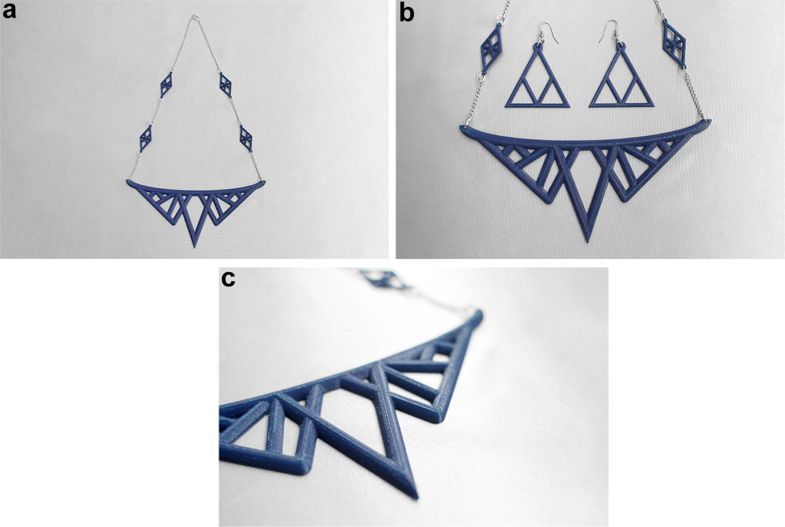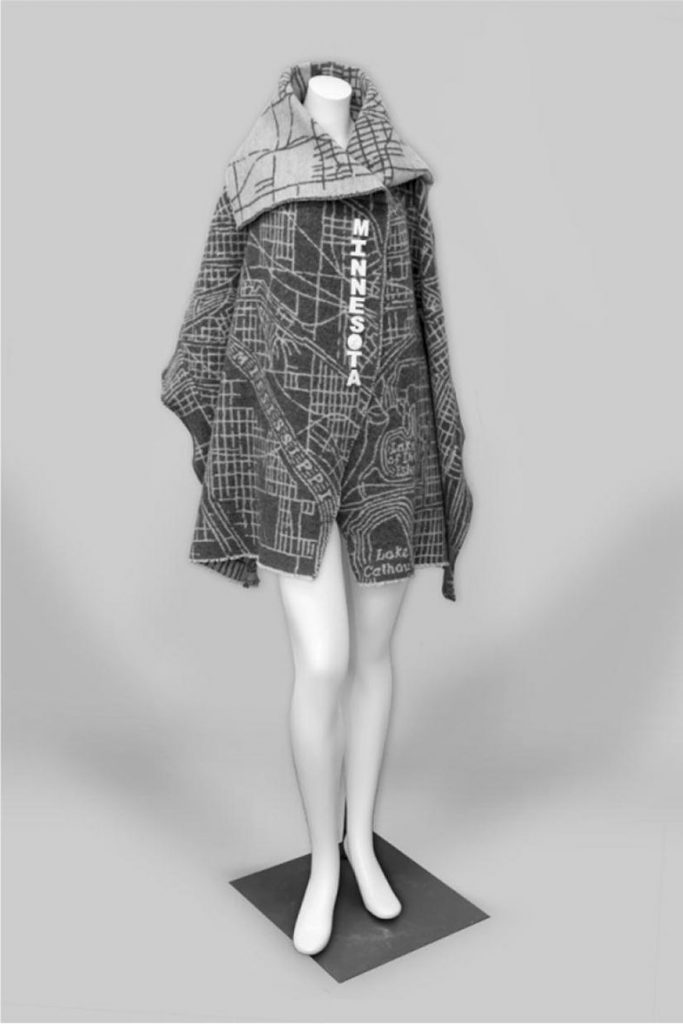 3D printing has allowed fashion designers all over the world to take their talents to new levels, whether in creating new 3D knitting processes, biodegradable clothing, maternity wear, and so much more. Now, St. Catherine University researchers Anupama Pasricha and Rachel Greeninger have published new findings regarding 3D printed fashion in ‘Exploration of 3D printing to create zero-waste sustainable fashion notions and jewelry.’
3D printing has allowed fashion designers all over the world to take their talents to new levels, whether in creating new 3D knitting processes, biodegradable clothing, maternity wear, and so much more. Now, St. Catherine University researchers Anupama Pasricha and Rachel Greeninger have published new findings regarding 3D printed fashion in ‘Exploration of 3D printing to create zero-waste sustainable fashion notions and jewelry.’
The research duo explored the sustainability of zero-waste application in 3D printing using a variety of different modeling tools, including Rhinoceros 5 and Tinkercad, 3D printing on a MakerBot Replicator 2. While most studies have focused on materials and hardware research, this data reflects a new concern in making efforts to reduce waste—and to further disrupt an already disruptive technology.
One of the main ways the researchers were able to reduce waste was in the obvious: cutting back on or eliminating the extra material found in rafts and support. The authors state that, according to the Zero-waste International Alliance, zero waste is a philosophy dependent on:
“… designing and managing products and processes to systematically avoid and eliminate the volume and toxicity of waste and materials, conserve and recover all resources, and not burn or bury them.”
In discussing the revolutionary aspects of 3D printing on the world and industry in particular, Pasricha and Greeninger see this technology as also having the potential to ‘redefine the ready-to-wear fashion industry,’ using bold designers like Iris van Herpen as an example. The study focuses mainly on whether 3D printed fashion is a sustainable ideal, minimizing waste while still fabricating customized, wearer-specific fashions.
They also state that Fair Trade plastic could play a part in such endeavors, especially via ethical filament standards created by material scientists like Joshua Pearce. And while many of the fashions—especially some of the more outrageous haute couture—may seem completely unrealistic, the medium continues to develop more for the average consumer, especially as designers begin to explore more 3D printing in connection with different types of conventional cloth, and even creating smart products. Fabrication of jewelry is a growing trend too, and many different companies are producing innovative rings, bracelets, and more in custom 3D printed jewelry lines.
Footwear manufacturers have targeted 3D printing heavily in recent years, with companies like Nike and Adidas exploring the epic customization techniques suddenly becoming available as they outfit athletes and the general public too. The researchers state—and of course, this is true for everyone except for the most tech savvy—learning to 3D print apparel and accessories with 3D printing is not easy and there is a steep learning curve. The ability to make rapid prototypes is a huge advantage for many designers, but especially those engaging in fashion—and prototyping offers potential for reducing waste as 3D printing allows for easy digital editing.
‘Zero waste’ is not a common topic, however. To shed more light on sustainability in fashion, the researchers (denoting themselves as Researcher A and Researcher B) each took a unique and creative approach, making both clothing and jewelry with minimized waste. Researcher A 3D printed Design 1 Ensemble made up of a cape and eight customized buttons. Researcher B made five necklace pendants and two pairs of earrings in Design 2 Ensemble.
“Their designs emerged from exploring design as well as 3D modelling software in creating unique shapes and structures ensuring durability and zero-waste and using minimum plastic,” states the research paper. “Respecting the principle of sustainability, the researchers abstained from buying new colors of materials utilizing those already available at their institution.”
The designers used PLA in white, clear, and blue, 3D printing on the MakerBot 2 with settings conducive to reducing waste in output.
“In their creative design as research method, the researchers hoped to develop a 3D process for building fashion notions and jewelry that yielded zero-waste. To that end, following a steep learning curve facilitated by Lynda.com tutorials, as well as several trial runs on the CAD-based tools, 3D modeling MakerBot software, and the 3D printer platform, the researchers developed expertise in design and design strategies,” states the research paper. “During the learning process, researchers were able to identify limitations and create desired shapes without waste.”
In the cape design Researcher A used 95 percent of the fabric allowed for the project, sewing and piecing together material to eliminate waste.
“The front was adorned with customized zero-waste 3D printed buttons to complement the fabric design. Two fabric-covered snaps were applied to create the closure. The raw edges were finished with a 3/8th” fringe for the hem and collar and a blanket stitch for the placket using yarns extracted from the fabric.”
Designer 2 created jewelry designs in pendant form, finishing them with gold paint to imbue the pieces with a metallic sheen. The researchers point out that this work would have only been possible with the Rhinoceros 5 modeling tool (something we’re a bit sceptical about).
“Researcher B developed intermediate skills in designing and printing in 3D,” states the data. “These designs can also be refined in terms of sustainability by exploring layer height, printing speed and quality, infill, number of shells, and extruder temperature.”

a Jewelry pendant design 1(blue color PLA filament). b Jewelry pendant design 1 with earrings. c Zoomed view of jewelry pendant design 1

a Jewelry pendant design 1(blue color PLA filament). b Jewelry pendant design 1 with earrings. c Zoomed view of jewelry pendant design 1
The project is inspiring due to the creativity in new fashion, but also because they were able to reduce waste significantly, and especially as they learned to fabricate without the use of rafts (also called brim, rafts and skirts). Recommendations for the future involve exploring materials other than PLA as it may not be able to hold up to the rigors of being washed.
The authors conclude by stating that ‘further strategies to develop critical viewpoint to expand the sustainability attribute and its application through divergent, 3D design thinking, including choice of philosophy, materials and equipment will shape new narratives of 3D printing and zero-waste, sustainable fashion.’
What do you think of this news? Let us know your thoughts! Join the discussion of this and other 3D printing topics at 3DPrintBoard.com.
[Source / Images: ‘Exploration of 3D printing to create zero-waste sustainable fashion notions and jewelry’]Subscribe to Our Email Newsletter
Stay up-to-date on all the latest news from the 3D printing industry and receive information and offers from third party vendors.
You May Also Like
Precision at the Microscale: UK Researchers Advance Medical Devices with BMF’s 3D Printing Tech
University of Nottingham researchers are using Boston Micro Fabrication‘s (BMF) 3D printing technology to develop medical devices that improve compatibility with human tissue. Funded by a UK grant, this project...
3D Printing Webinar and Event Roundup: April 21, 2024
It’s another busy week of webinars and events, starting with Hannover Messe in Germany and continuing with Metalcasting Congress, Chinaplas, TechBlick’s Innovation Festival, and more. Stratasys continues its advanced training...
3D Printing Webinar and Event Roundup: March 17, 2024
It’s another busy week of webinars and events, including SALMED 2024 and AM Forum in Berlin. Stratasys continues its in-person training and is offering two webinars, ASTM is holding a...
3D Printed Micro Antenna is 15% Smaller and 6X Lighter
Horizon Microtechnologies has achieved success in creating a high-frequency D-Band horn antenna through micro 3D printing. However, this achievement did not rely solely on 3D printing; it involved a combination...






























